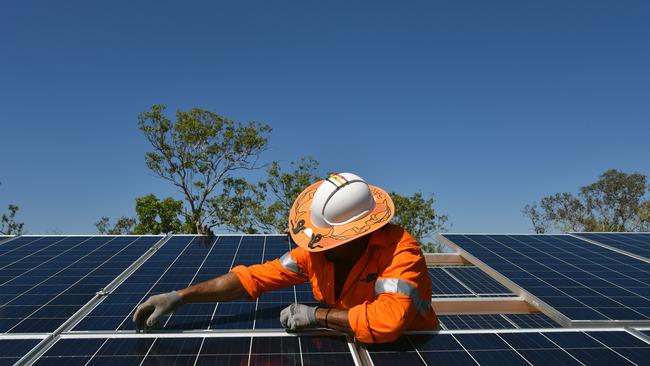
Move over, Ponzi; forget Bernie Madoff; ignore Enron; and dismiss collateralised debt obligations associated with subprime mortgages. Without a doubt, the biggest scam perpetrated against taxpayers and consumers is renewable energy.
And if you think this scam is just an Australian phenomenon, think again. With very few exceptions, governments all over the world have fallen into the trap of paying renewable energy scammers on the basis that it is necessary, at least politically, to be seen to be doing something about climate change.
But let’s take the Australian figures as an example of the vast sums of moneys being redistributed from ordinary consumers and taxpayers to the renewable energy rent-seekers. It is estimated that more than $2 billion a year is handed over to renewable energy operators by virtue of the operation of the renewable energy target and the associated renewable energy certificates.
But this is just the start. The Australian Renewable Energy Agency shovels out hundreds of millions of dollars annually to subsidise renewable energy companies, many of which are overseas-owned. Then there is the Clean Energy Finance Corporation, which was given $10bn in equity by the Gillard Labor government to lend or grant money to renewable energy companies. Evidently the long-suffering taxpayer might receive a return on this “investment”, but I wouldn’t suggest you hold your breath.
Then we have the actions of deluded state governments and their absurd renewable energy targets. Using the dubious technique of reverse auctions, state governments are effectively providing guaranteed cashflows to renewable energy companies for intermittent power using taxpayers’ money. Think Victorian and the ACT here, but Queensland is about to get in on the act.
It would be a worthwhile exercise to add up the value of all these subsidies, grants, concessional loans, guarantees and the like so we can get an appreciation of the size of the scam. There is no doubt the aggregate amount dwarfs any other government industry assistance aid, including for the now defunct automotive industry.
In point of fact, the amount of direct and indirect assistance given to those international car companies through the years looks like small beer compared with the renewable energy scam. But here’s the thing: people finally appreciated that the high levels of assistance to the car industry did not benefit consumers. Exactly the same point applies to subsidising renewable energy.
Consider what has happened in Germany. In a fit of panicked madness, Chancellor Angela Merkel decided the country’s nuclear power plants should be shut down, to be replaced with renewable energy. The plan is that by 2050, between 80 per cent and 95 per cent of electricity will be generated by renewables. The target for 2030 is 50 per cent — the same as our Labor Party’s target for Australia.
The last nuclear power plant is due to close in 2022 but Energiewende, the name of the plan to transition electricity generation, has hit serious hurdles, not least the extraordinary cost of the investment in renewables, now totalling about €650bn ($980bn).
And here’s another strange feature: renewable energy producers in Germany are paid more than €1bn a year not to produce because the stability of the system can be imperilled if there is too much renewable energy at certain times. It’s so European to pay an outfit not to do something — just think farmers.
Because the nuclear power plants were largely in the south of the country and the wind farms are in the north (where the wind blows), there is a need for substantial investment in new transmission lines. As a result of public objections to these unsightly new pylons, the decision has been taken to put the lines underground — at eight times the cost of the above-ground versions. It is now estimated the required new infrastructure will take much longer to complete, well beyond the 2022 deadline. The costs to the consumer of the German government’s radical policies are substantial. There is a specific levy paid for green energy, and retail electricity costs in the country are second only to Denmark within the EU.
Cunningly, the government has largely exempted large industrial users from the cost of Energiewende. And the absurdly high and long-lasting feed-in tariffs for households with solar panels — does the sun shine much in Germany, you ask? — has underpinned support for the policy.
But the real kicker is this: Germany will fail to meet its emissions reduction targets of 2020, set at a 40 per cent reduction from 1990. The actual figure is likely to come in at 32 per cent. Note that the decommissioning of highly inefficient, rust-bucket factories in east Germany in the early 1990s was a boon to meeting the target set by the government.
Then there is the issue of intermittency that plagues renewable energy around the world, including in Germany. Late last year, the wind simply didn’t blow for several days and a thick fog surrounded many parts of the country. The output from renewables fell to just 4 per cent of total demand. Battery back-up is of little use in this scenario.
That Germany’s electricity system is connected to neighbouring countries meant demand could still be met. Poland, with its black coal-fired electricity plants, in particular was able to fill the breach. But here’s the thing: Poland is now questioning if it will continue to accept wind-powered electricity from Germany because the profitability of its electricity plants is being undercut. There is talk of a block being imposed.
Of course, it’s not just the Germans who have fallen for this expensive scam. In Britain, the cost of renewable energy is still off the charts, although the cost of wind farms, now virtually all offshore because of local opposition, has fallen recently. But the figures are quite staggering.
In what is the mother of all subsidy schemes, the government holds auctions to award long-term contracts to companies on the basis of megawatt hours produced. There are now contracts in Britain whereby producers are paid £150 a megawatt hour (more than $250/MWh) for wind power produced.
The most recent round has still produced figures of more than £100/MWh, which is insane. And note that Britain continues to burn woodchips imported from the US to produce electricity because of the supposed environmental benefits. You know it makes sense.
In 50 years — hopefully sooner — my successor commentators will look back and wonder what the world was doing.
As the Australian government contemplates where to go next in terms of energy policy, the best approach involves acknowledging that enough is enough when it comes to subsidising renewable energy. The sector has been showered with favours, including volumetric guarantees courtesy of the RET. It is time it stood on its own two feet without any preferential treatment or financial assistance.




To join the conversation, please log in. Don't have an account? Register
Join the conversation, you are commenting as Logout